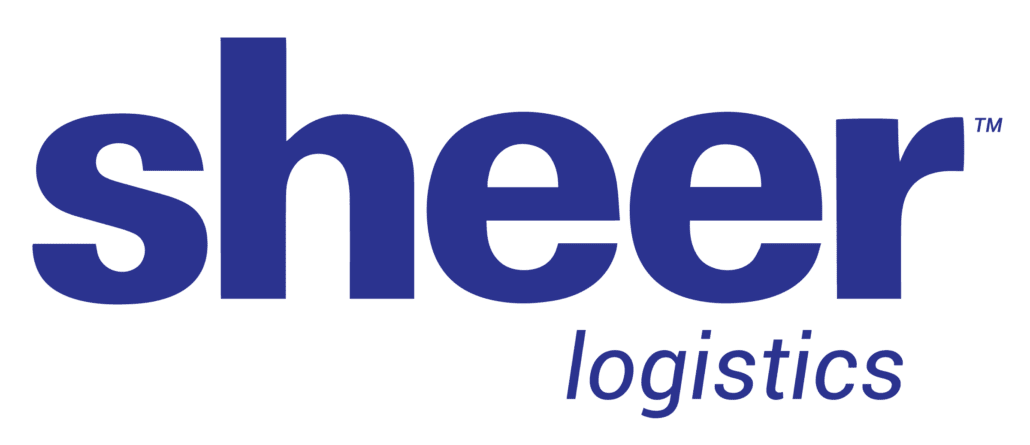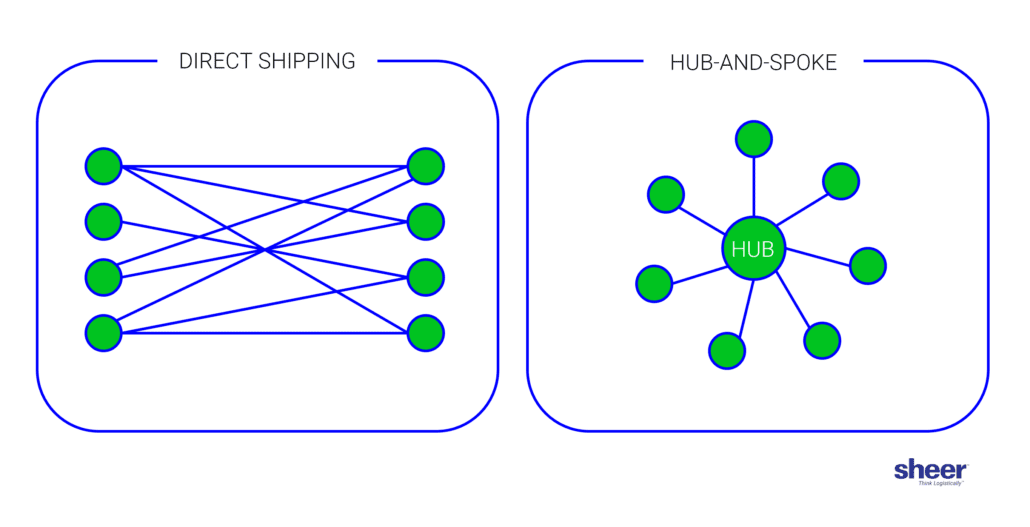
Point-to-Point vs. Hub and Spoke
The point-to-point distribution model is a delivery system where shipments are delivered directly to the final destination without consolidation. This means that every shipment requires its own delivery and resources, resulting in significantly higher costs and longer delivery times. Additionally, this method doesn’t allow for easy tracking of shipments or for other transportation techniques to be used simultaneously.
Applications in Different Modes of Transportation
The hub and spoke model is utilized across a variety of modes of transportation, including air, rail, over the road, and in the maritime industry. Here are some examples of transportation companies that utilize the hub and spoke model:
- Air:
-
- Commercial airlines such as Delta Air Lines, American Airlines and United Airlines. Commercial airlines utilize hubs, or major airports where flights are consolidated from origin points across their network and passengers and cargo are transferred to other flights heading toward their final destinations. In contrast, Southwest Airlines utilizes a point-to-point network.
-
- Cargo airlines such as UPS and FedEx
- Railroads, such as Union Pacific Railroad, CSX Transportation and BNSF Railway
- Trucking and Logistics Providers:
-
- Parcel companies such as FedEx Ground and UPS
-
- Asset-based logistics providers (both truckload and LTL)
- Maritime lines such as Maersk Line and Hapag-Lloyd use a hub and spoke system that is similar to the approach utilized by airlines. Major ports serve as hubs where ships from smaller ports converge, consolidate, sort and redistribute shipments.
Having trouble tracking your shipments in real time? Discover how integrating the right technology can improve your supply chain visibility.
Benefits of the Hub and Spoke Model
Using a hub and spoke distribution model has several advantages for your business, including:
Simplified Shipping Processes
One of the most significant advantages of the hub and spoke model is that it simplifies (and centralizes) your shipping processes. The shipping and logistics industry is full of complex moving parts, making it challenging for many companies to run their operations effectively. By providing a single point of consolidation for all of your shipments, the hub and spoke model streamlines many processes, such as planning, loading, unloading, and inventory management. This makes it easier to complete deliveries in a timely and cost-effective manner.
Optimized Route Planning And Delivery
The hub and spoke model is also an effective way to optimize route planning and delivery. Using a centralized hub, carriers can reduce their point-to-point routes, allowing them to sort and deliver orders in the most efficient manner.
A More Sustainable Supply Chain Operation
Similarly, by reducing the number of vehicles and routes required to deliver goods, your shipping and receiving processes use less fuel. This reduces your carbon emissions and allows you to operate more sustainably.
Lower Costs
Another key benefit of the hub and spoke model is that it provides numerous opportunities for cost savings. It primarily does this by reducing labor costs associated with shipping and delivery. By consolidating shipments in a centralized location, fewer workers are required to manage inventory and process shipments. This reduces the need for additional personnel and eliminates the overhead costs associated with managing multiple warehouses or distribution centers.
A hub and spoke network also reduces transportation costs by reducing the need for point-to-point delivery. Instead of shipping goods directly from one location to another, carriers can use hubs as the primary locations for processing and sorting orders. This allows carriers to reduce the number of trips needed to deliver shipments, resulting in fewer fuel costs, less time spent on the road, and, ultimately, improved delivery times.
Improved Efficiency And Overall Productivity
The hub and spoke model offers businesses improved efficiency and productivity. By consolidating all of their shipments at one location, companies can reduce the number of warehouses or distribution centers they need to manage by centralizing inventory management. This streamlines the order processing and shipping process, allowing businesses to process more orders in less time. Additionally, carriers can create multiple hubs throughout their network, allowing them to sort and route orders to their final destinations quickly.
The hub and spoke model also allows for greater flexibility when it comes to managing customer orders. Companies can easily adjust their delivery schedules based on customer demand and seasonality since the centralized hub allows easy access to a wide variety of inventory. This enables companies to respond quickly to changing customer needs while also saving money on unnecessary transportation costs.
Challenges and Limitations
While the LTL hub and spoke model has its advantages, there are also challenges and limitations that shippers should be aware of.
- Increased transit times (as compared to direct route shipping methods) can result as shipments pass through multiple hubs. In addition, delays or congestion at hubs can further lengthen the overall transit times of your shipments.
- Lost or damaged shipments loss is a risk inherent to the hub and spoke model. Because each shipment has multiple “touches,” the risk of damage or loss increases compared to direct shipping. Also, because the shipment essentially travels along multiple “legs” to its final destination, there is increased risk that shipment is misdirected or misrouted.
- Lack of visibility to shipments is a common challenge with the hub and spoke approach. This is due to the multiple touchpoints for each shipment, delays in entering tracking information into the TMS, lack of integration between disparate systems, and other causes. This lack of visibility can be frustrating not only to the shipper but also to end-customers who may lack timely updates on the status of their shipment.
- Single point of failure: Disruptions at a central hub due to operational failures, strikes, or natural disasters, can impact the entire network.
Using a TMS to Manage Your Hub and Spoke Model
Transportation management software (TMS) is an essential tool for businesses that use a hub and spoke distribution model. A TMS provides your company with the crucial data and insight you need to run your operations effectively. In fact, it has a similar structure to the hub and spoke model—data, such as estimated delivery times, weather forecasts, predicted customer demand, and more, are pulled from various sources and aggregated in one central dashboard.
By providing such increased visibility, your TMS allows you to adjust your hub and spoke model to maximize its effectiveness.
Leverage Technology in Your Supply Chain With Sheer Logistics
Whether you use a point-to-point or hub and spoke distribution model, your supply chain operations won’t function optimally without the proper visibility and data-driven insights. Contact us today to discuss how the right technology solution can overhaul your supply chain.










